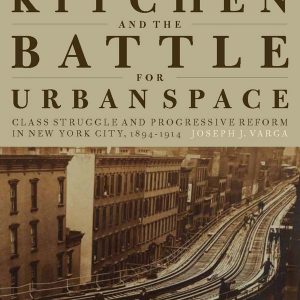Book Reviews
(from New York History, a quarterly publication of the New York State Historical Association partnered with the State University of New York-College at Oneonta)
Hell’s Kitchen and the Battle for Urban Space: Class Struggle and Progressive Reform in New York City, 1894–1914.
By Joseph J. Varga. New York: Monthly Review Press, 2013, 272 pages, $18.95 Paper.
Reviewed by Juandrea Bates, University of Texas at Austin
Hell’s Kitchen’s tenements have long captured the attention of reformers, scholars, and the American public. In Hell’s Kitchen and the Battle for Urban Space, Joseph J. Varga combines a sophisticated use of critical space theory, with a nuanced investigation of social relations among residents, reformers, and state agencies, to shed light on development in this notorious neighborhood during the Progressive Era’s transformative years. Utilizing Henri Lefebvre’s understanding of space as “lived, conceived and perceived,” Varga reveals that the physical features of the area, social relationships of work and home, reform efforts, ethnic and racial alliances, and government allotment of funds played a role in creating and giving meaning to space on Manhattan’s Middle West Side.
Varga divides his study into six chapters. Historians can safely skip over the first chapter, a somewhat repetitive theoretical discussion of space, and focus on the empirically rich, middle chapters. In the second chapter, Varga analyzes the “spatial archive of the built environment”—documentary photographs, charts, diagrams, and graphs produced by scientists and government agencies. He concludes that Progressives forged discursive connections between space and the moral behavior of the poor, thereby making the investigation and improvement of urban space critical to social uplift. Crowded slums, they argued, shielded working-class residents from the judgmental gaze of the middle class and thereby promoted an atmosphere of ill health, vice, and deviant sexuality. This gave reformers cause to focus on developing wide streets and on building public parks and model tenements that would cultivate better citizens.
Ultimately, negotiations over space, the arrangement of capitalist work relationships, the local population, and even the physical characteristics of Hell’s Kitchen mediated Progressives’ plans for urban reform. For example, while the city’s political and economic leaders acknowledged the need to enforce housing standards and build small parks, their plans faced opposition from landlords seeking to maximize profits, industrialists contending for cheap land along the waterfront, and local residents’ desires for autonomy and privacy. Even when Progressives did alter physical space, they could not cultivate a shared vision for the area among local residents. Reformers successfully inaugurated Dewitt Clinton Park in 1905, but the following decade saw it fall into disrepair and disuse. Nonetheless, their understanding of urban space as intimately linked to public morality became the dominate discourse underlying debates over urban reform at the turn of the century and, even today, it continues to shape our understanding of urban design.
Several excellent sections offer rich descriptions of youthful recreation on rooftops, young mothers repurposing tenement hallways into childcare centers, and dockworkers performing dangerous, sometimes deadly, acts of masculinity along the piers. Varga skillfully reconstructs Hell’s Kitchen’s populace as a heterogeneous bunch with distinct gender and ethnic identities, among whom alliances could shift quickly. While these differences sometimes resulted in violence, Varga reveals that identity and communal norms were more often negotiated through mundane aspects of everyday life, such as who traded the autonomy of privately rented apartments for the amenities of model tenements. In a final chapter, Varga details local residents’ success in advocating for their own improvement projects: the removal of train tracks from Eleventh Street and the opening of an amusement park on the Fifty-First Street Pier.
Finally, Varga convincingly argues that urban space modified meanings of citizenship in turn-of-the-century Manhattan. Using police reports and court cases, Varga reveals that Hell’s Kitchen constituted a “frozen zone” of criminal activity and police corruption. Here, law officers permitted crime and acted with impunity. Innocent acts, such as standing on a street corner or reporting domestic violence, could result in arrest and vicious treatment at the hands of the police. Despite holding official citizenship, residents of Manhattan’s Middle West Side found that living in Hell’s Kitchen often curtailed their rights, as state officials refused them fair treatment before the law. The undermining of citizenship rights by authorities encouraged people to reject traditional political engagement in favor of racial and ethnic solidarities.
Hell’s Kitchen comes alive in Varga’s descriptions of how urban inhabitants made use of the space around them, but this social history is often given short shift to a more theoretical engagement with critical space theory. Nonetheless, Varga skillfully demonstrates the importance of taking space seriously, and in doing so, provides a wealth of new insights into community formation, the meanings of progressive reform, and the value of citizenship in turn-of-the-century New York City. In doing so, he raises provocative questions about New York State’s other urban centers. Readers of New York History looking for an easy read or focused social history should probably skip this volume, but for those interested in how to “take space seriously” and those searching out new ways to understand the relationships between New York State’s cities and its people, Hell’s Kitchen and the Battle of Space is an invaluable read.

Comments are closed.